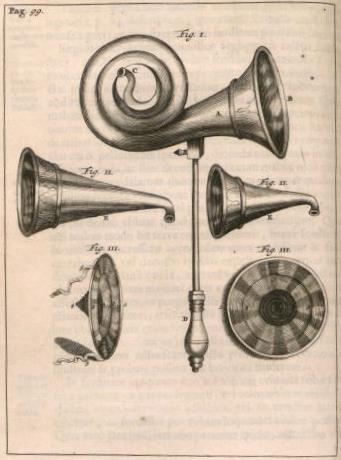
We may take it for granted that our hearing aids are barely detectable, can be managed with our cell phones, and can distinguish between speech and background sound. What we might not realize, however, is that those features are the results of 400 years of experiment, design, and refinement.
Even as early as 5 years ago, hearing aids could not yield the clarity of sound produced today. To understand why, let’s follow the history of hearing aids—beginning today and going in reverse—to see how hearing aids would have treated your hearing loss in four different years: 2016, 1985, 1940, and 1650.
2016 – Modern Day Digital Hearing Aids
It’s 2016 and you’re searching to address your hearing loss. You open up an internet browser, search for a nearby hearing care provider, complete a brief form, and arrange a consultation.
At your hearing exam, your hearing is screened using advanced computer technology that accurately evaluates your hearing. Then, with the help of your hearing care professional, you select a hearing aid that meets your needs from an extensive selection of models.
Then, your hearing instrument specialist programs your new hearing aids to enhance only the sounds and frequencies you have difficulty hearing, giving you crystal clear sound without distortion.
If you were to tell anyone in the 1980’s that this would be the process, they wouldn’t have thought it was possible.
So what did make it possible? In a nutshell, digital technology.
For the majority of their history, there was no way for hearing aids to differentiate between different sound frequencies. Hearing aids would enhance all inbound sound, including background noise, creating distorted sound.
The digital revolution cleared up that problem. With digital technology, all information can be altered, stored, and manipulated as permutations of 0’s and 1’s. Digital technology allowed hearing aids to convert sound frequencies into digital information, which could then be grouped in accordance with which sounds should be amplified (speech) and which should be restrained (background noise).
The first all-digital hearing aid was developed in 1995, and since then the technology has improved tremendously, ultimately to include wireless capability.
1985 – Transistor Hearing Aids
Now, imagine it’s 1985 and you’re looking to treat your hearing loss. You can forget searching for a local hearing care provider on the internet because the first commercial internet service provider won’t be established until 1989.
You’d have to use the phone book, rely on referrals, or drive around the neighborhood to find a hearing care practice.
After scheduling an appointment and having your hearing screened, your choices for hearing aids are quite restricted. With no microprocessor and digital technology, hearing aids were manufactured with a series of transistors. This adds size and higher power requirements, leading to bigger batteries and larger hearing aids.
Additionally, without the benefit of digital technology, the hearing aid cannot distinguish between different frequencies of sound. Hearing aids receive inbound sound and the transistors act as basic amplifiers, amplifying all sound. So if you’re in a loud room, speech recognition will be virtually impossible.
1940 – Vacuum Tube Hearing Aids
It’s 1940 and you’re considering purchasing a hearing aid. Transistors haven’t been applied to hearing aids yet, so your choices are confined to vacuum tube hearing aids.
Vacuum tubes consume more power than transistors, so the hearing aids demand larger batteries, making the hearing aids big, heavy, and cumbersome.
And once again, without digital technology, the hearing aids can only act as straightforward amplification systems, making all inbound sound louder. The hearing aids cannot enhance speech and can’t filter out background noise.
1650 – Ear Trumpets
Let’s go all the way back to 1650. There’s no digital technology, no transistors, and no vacuum tubes. That means no way to transform sound into electrical currents that can be amplified.
With electrical amplification unattainable, your only option is mechanical amplification by focusing and compressing sound into the ear canal, such as what happens when you cup your hands around your ears.
By 1650, devices were developed that focused inbound sound into the ears, and these devices were named ear trumpets. They were prominent devices with a conical end that collected sound and a narrow end that concentrated the sound into the ear.
This would be the only technology available to individuals with hearing loss for the next 250 plus years.
Let’s return to 2016. Throughout more than 400 years of history, hearing aids have grown from mechanical amplification devices to electrical amplification devices, from vacuum-tube-based to digital-based. They’ve become progressively more compact, lighter, and more efficient and affordable.
They’ve also become much better at distinguishing among various types of sound, and in amplifying only certain types of sound (such as amplifying speech while suppressing background noise).
Each generation of hearing aid has generated a major improvement over the previous generation. The question is, what’s the next major milestone in the history of hearing aids?
Will we eventually be able to enhance natural human hearing, rather than merely restore it?